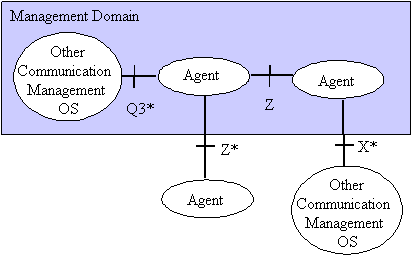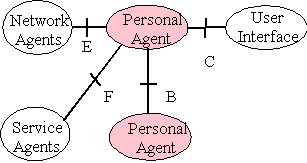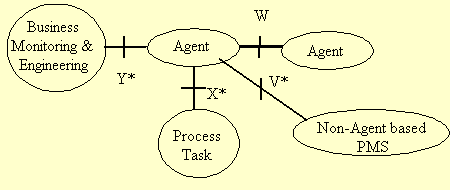
BT FIPA Report
Application of Intelligent Agents
to Telecommunications
Author(s) : Paul O'Brien, Nader Azarmi, Richard Nicol.
Intelligent Systems Research
Advanced Applications and Technology

0. Summary
This proposal describes four applications of intelligent agent technology to
telecommunications. Each application area has an associated reference model to identify the
key interfaces and provide a framework for standardisation in FIPA. These reference models
take into account existing standardisation initiatives.
1.0 Personal Agent Services
1.1 Scenario
Personal agent systems model the interests of users and provide services as and when
required. For example, the Meeting Scheduler personal agent organises meetings on behalf of
a user. It behaves like an automated personal assistant. Its functionality includes :
1.2 Reference Model
A reference model can be identified to delineate the key interfaces for personal agent systems.
Figure 1 illustrates these interfaces and the main system components of a personal agent
system.
Persistent information relating to a users personal preferences would be stored in a User
Profile (UP). When a user wishes a task to be performed (e.g. set-up a meeting with a
number of participants), the relevant task (e.g. meeting scheduler) accesses the users UP. This
composite object of task + UP represents a personal agent. The personal agent then interacts
with other agents to organise the meeting.
Four interfaces can be identified. Interface A supports interaction between UPs and tasks.
Interface B supports the interaction between personal agents. Interface C supports user
interaction with tasks. In the case of an internet service this would be via an internet browser,
in which case it would have to conform to the hypertext transfer protocol (HTTP). Interface
D supports inter-operability between tasks in support of the service offered by a personal
agent.
One important issue associated with standardising these interfaces is security. Personal agents
represent the interests of individuals and will have access to personal information. Ensuring the
confidentiality and integrity of this information is paramount if user confidence in personal
agent technology is to be achieved.

Figure 1, Personal Agent Reference Model
The value of standardising these interfaces would be :
2.0 Network Provisioning
2.1 Scenario
A global telecommunications system is a large, massively distributed system. Components of
that system are owned by different organisations which inter-operate to ensure a global
end-to-end service can be provided. Network provisioning consists of those activities
required to resource an end-to-end network connection.
An agent-based network provisioning system would consist of autonomous agents
representing the interests of telecommunication providers. The agents buy and sell network
capacity in support of end-to-end communication links. The agents would negotiate over
parameters such as quality, time and cost, as well as how such links are to be managed.
When exceptions occur, the agents co-operate in order to resolve the exception.
There are two areas of agent functionality in this application area :
2.2 Reference Model
Agreed standards already exist covering communications management. The ITU M3010
provides a reference model for telecommunications management which is supported by the
telecommunications industry. Network provisioning agents can be incorporated into the
existing ITU reference architecture by adapting existing ITU interfaces and by the addition of
other interfaces.
Figure 2, provides a possible reference model for agents in communications management.
Interfaces Q3* and X* represent enhanced Q3 and X ITU interfaces (cf. ITU M3010
"Principles for Telecommunications Management Network") with existing non-agent
management systems.
Interfaces Z and Z* represent new interfaces. Z represents the interface between agents
within the same management domain, whereas Z* represents the interface between agents
from different management domains. A key difference between these two interfaces would be
the inclusion of security safeguards in Z* because it represents an inter-organisational
interface.

Figure 2, Reference Model for Agents and Communications Management
3.0 Multi-Media Service Management
3.1 Scenario
Telecommunications services comprise many types of media, (i.e. voice, text, pictures, video, raw data) which can be accessed through a variety of terminal devices, (i.e. telephone, computer, TV etc.) all of which are not totally inter-operable. A Multi-Media Service Management (MMSM) system is capable of delivering a variety of media in the most appropriate form for the recipient. For example, an urgent email being sent to a mobile user could be translated from text to speech and transmitted to the users mobile phone.
Such a system requires :
3.2 Reference Model
Defining a reference model for this application area is difficult due to the variety of
telecommunication service platforms an agent based MMSM system would inter-operate
with.
Figure 3 outlines a reference model which could be adopted for MMSM. Interfaces B and C
are the same as those described in section 1. Service agents manage value-added services
such as text-to-speech translation. Network agents manage the access to and use of network
resources. Interfaces E and F support access to these services and resources by personal
agents.

Figure 3, Reference Model for MMSM
The modules outlined in figure 3 would not exist in isolation but would interact with existing
telecommunications service platforms. There are three main bodies which define such
platforms which should be related into this reference model, they are :
4.0 Agent-based Business Process Management (APMS)
4.1 Scenario
Organisations are naturally distributed into business units or departments which need to
collaborate in order to manage an end-to-end business process. Agent-based business
process management systems (APMS) use autonomous agents to represent the interests of
business units which negotiate about how to provision and execute business processes.

Figure 4, The APMS Reference Model
The only standardisation body in the area of business process management is the Workflow Management Coalition (WMC) which has defined its own interfaces. Y*, X* and V* represent enhanced WMC interfaces. FIPA could represent a pressure group pushing for the extension of WMC interfaces to support APMS.
This document describes key agents application areas in telecommunications. It is proposed
that FIPA follows these key steps to standardising both these agent application areas and
others :
ITU (International Telecommunications Union)
WMC (Workflow Management Coalition)
http://www.aiai.ed.ac.uk:80/WfMC/
TINA : Telecommunications Information Networking Architecture